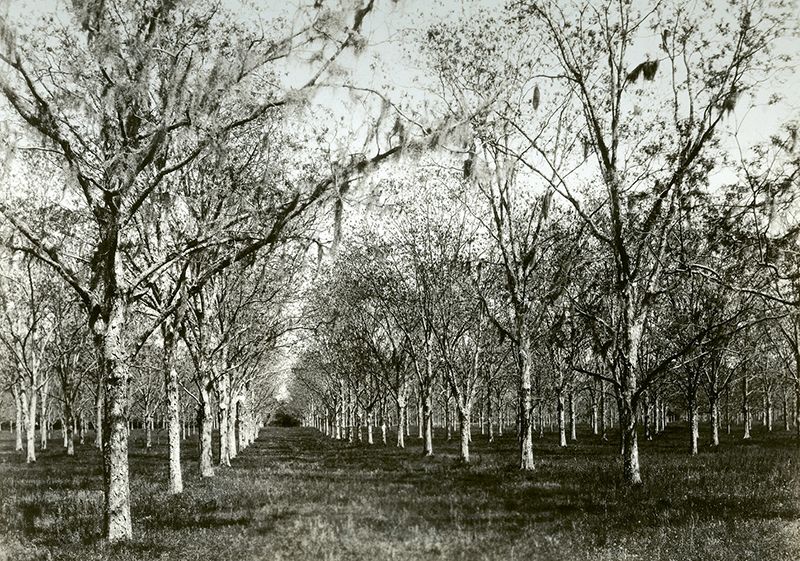For decades, the largest pecan farm in the world was at Boone Hall Plantation

Pecan-do Attitude: The pecan grove at Boone Hall Plantation once boasted 15,000 trees on 4,000 acres of land.
Though most of the South has regarded the pecan as a “home nut” and claimed pecan pie as its signature dessert, in reality the native range of the plant was limited to a rather constricted region of the Gulf Coast, from East Texas into Mississippi and up the Mississippi River Valley. American commercial cultivation of pecans didn’t begin until 1876, when the ‘Centennial’ variety was first planted in groves as far east as Georgia and northwest into Oklahoma.
One of the earliest growers was Boone Hall Plantation’s John Horlbeck. Horlbeck knew from personal experience that pecans could thrive in the Lowcountry thanks to a scattering of slow growing trees that had been planted in 1843 in the vicinity of Boone Hall’s great oak alley, and he secured cuttings of wild pecans from Louisiana sometime in the 1860s. Seeing the explosion of commercial groves in the deep South after the introduction of the ‘Stuart’ variety by the Bayview Pecan Company of Ocean Springs, Mississippi, his grandson, Major John S. Horlbeck, began planting extensive groves in 1892. The old plantation trees had produced numerous seedlings on the grounds; the most vigorous and quickest growing were selected to be the stock of the first planting. On these trees, he grafted ‘Stuart’ cuttings. Finally he experimented with the very thinshelled ‘Shley’ variety.
The scale of Major Horlbeck’s plantings was astonishing. A decade after beginning the project, Boone Hall boasted 15,000 trees, the largest pecan grove in the world. It occupied nearly a square mile of land, radiating on either side of the oak alley and extending throughout the 4,000-plus-acre tract. In October, workers would hit the trees with long poles, knocking the branches until the nuts fell; a second crew would then gather them on sheets.
The local demand was enormous—sufficient to purchase the entire yearly crop—but Major Horlbeck always reserved a portion of the largest nuts to sell to New York confectioners. He delighted in the metropolitan recognition of his pecans. Sweets stores sold Horlbeck’s harvest as raw nut meats, butter sautéed and coated with chocolate, stuffed into dates, and added to fruit cakes.
When Major Horlbeck’s health began to decline in 1912, wishing to see his great project live on, he sold the major part of the grove to the South Atlantic Pecan Company, a corporation organized by a pecan pomologist—a botanist who studies and cultivates fruit—Judson P. Welsh of Rutgers University. But Welsh didn’t turn over all of the Horlbeck holdings, reserving some choice groves for his personal use. The company, largely financed by businessmen F. H. Weston and W. T. Aycock of Columbia, was capitalized at $75,000, according to the November 8, 1912, Charleston Evening Post. Continuing to market the crop as Horlbeck Pecan Nuts, South Atlantic harvested 32 tons from the Boone Hall groves in 1914 alone.
When Major Horlbeck died in 1916, his heirs litigated to regain possession of the pecan orchard and succeeded. The Stone family took over in 1935. Today, visitors to Boone Hall can still glimpse the old trees that once provided the bulk of those delicious nuts to the world.
Image Courtesy of the South Carolina Historical Society